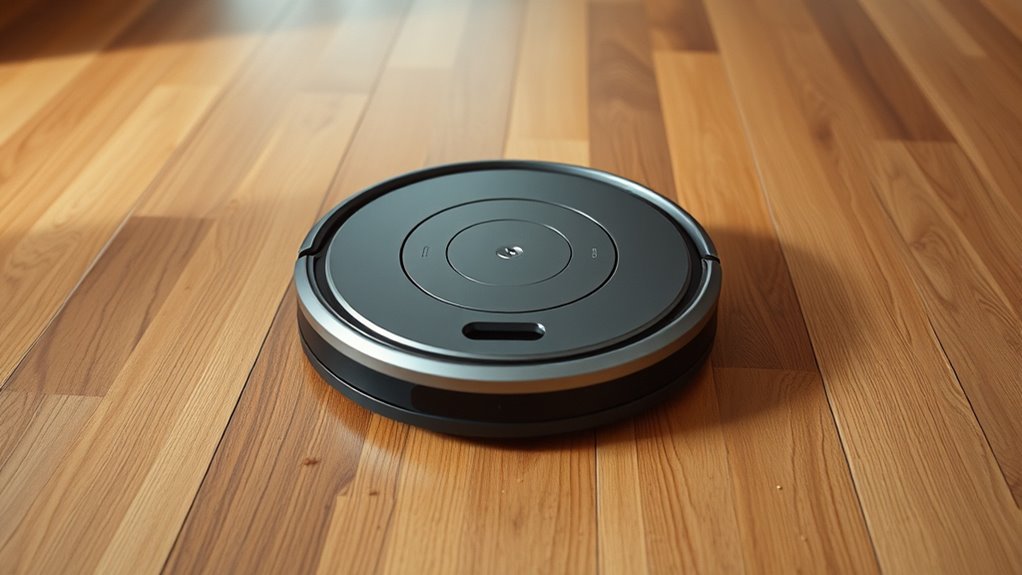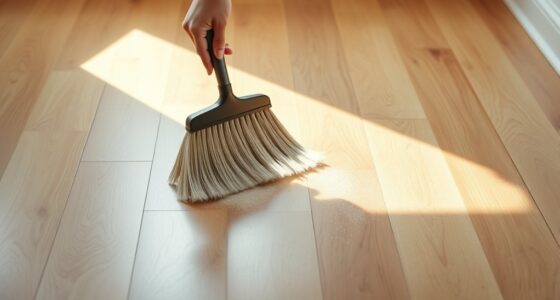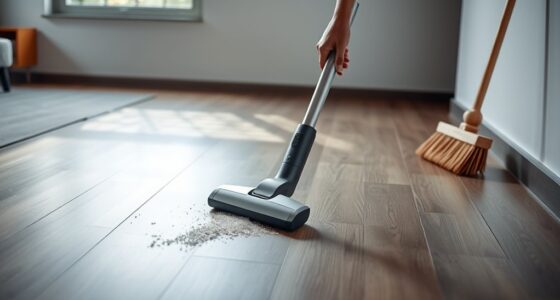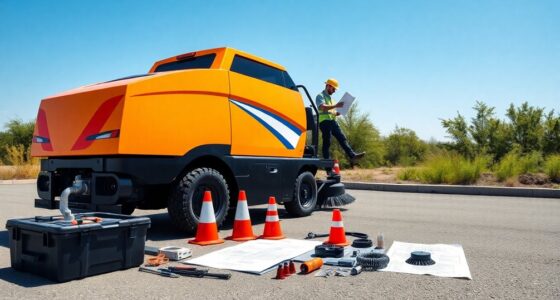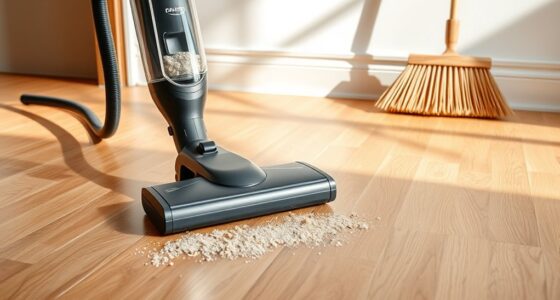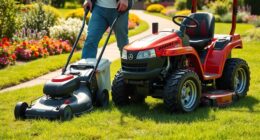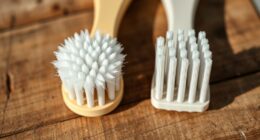To stop debris from scattering on your hardwood floors, you need to fix the forward-flip problem caused by loose or uneven rugs. Secure your rugs firmly with non-slip pads or double-sided tape to keep them flat and stable underfoot. Choose low-pile or tight-fiber rugs to reduce dirt escape, and guarantee proper rug placement in high-traffic areas. Properly secured rugs and well-maintained floors will help minimize dust and debris scatter—learn how to perfect this setup.
Key Takeaways
- Secure rug edges with non-slip pads to prevent shifting and minimize dirt escape during foot traffic.
- Use rugs with low pile and tight fibers to reduce dust trapping and debris displacement.
- Adjust vacuum height settings correctly to ensure proper contact with the floor and prevent debris scatter.
- Regularly clean and maintain vacuum brushes and filters for optimal suction and dirt pickup.
- Position rugs strategically in high-traffic areas to contain dirt and prevent it from spreading across hardwood floors.
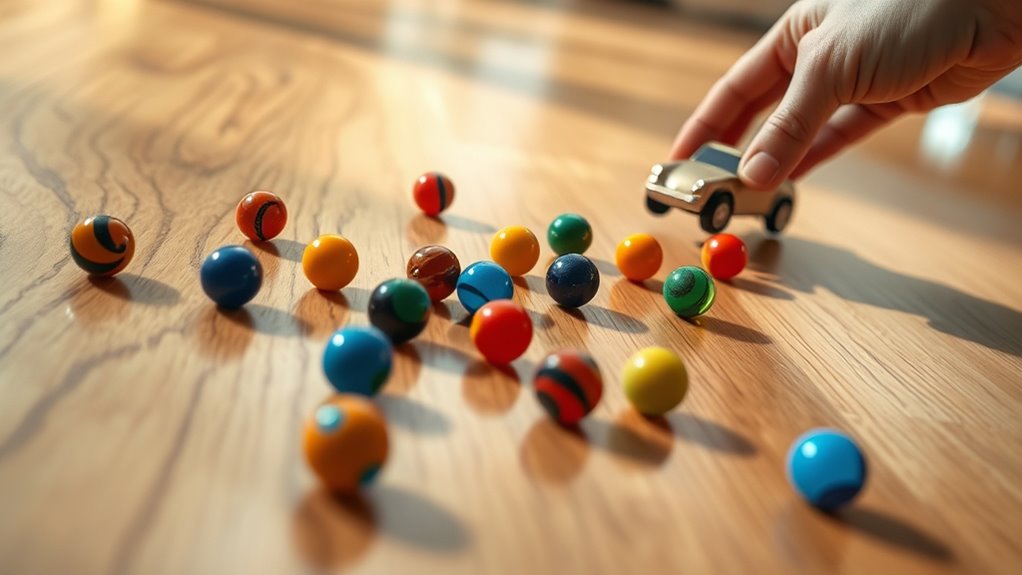
Have you ever noticed small debris and dust scattering across your hardwood floors whenever you walk? That scattering can be frustrating, especially when it seems like your vacuum is the culprit. Often, the problem isn’t just the vacuum itself but how it’s maintained and how rugs are placed in your space. To stop scatter on your hardwood floors, you need to address both vacuum maintenance and rug placement carefully.
First, consider how well your vacuum is functioning. If it hasn’t been maintained properly, its suction can weaken, leaving dirt behind that gets kicked up when you walk. Regular vacuum maintenance is essential. Check the brushes for tangled hair and debris, and replace filters as recommended by the manufacturer. A well-maintained vacuum will pick up dust and dirt more effectively, reducing the amount that gets disturbed as you move around. Also, make sure the vacuum’s height setting isn’t too high. If it’s raised too much, it won’t contact the floor properly, allowing dust to escape and scatter.
Next, pay attention to where you place your rugs. Rugs can trap dirt and debris, but if they’re not positioned correctly, they can actually contribute to scattering. For example, if a rug’s edges are loose or frayed, dirt can escape from underneath or get caught in the fibers, then get flicked into the air when you walk or vacuum over them. To minimize this, secure the edges of rugs with non-slip pads or double-sided tape, keeping them flat and stable. Also, choose rugs with tight, low-pile fibers that don’t trap as much dust and debris. When vacuuming, make sure to clean around and under rugs regularly, so dirt doesn’t accumulate beneath and get stirred up.
Additionally, consider the placement of rugs in high-traffic areas. Strategically positioning rugs can help contain dirt in one spot, making it easier to clean and less likely to scatter across your floors. Avoid placing rugs in areas where they can bunch or fold, as this can create uneven surfaces that disturb dirt and dust when walked on or vacuumed.
Finally, proper flooring maintenance plays a significant role in reducing dust scatter, so maintaining your hardwood surfaces with regular cleaning can further help keep debris in check.
Frequently Asked Questions
Can I Fix the Flip Problem Without Replacing My Entire Floor?
Yes, you can fix the flip problem without replacing your entire floor. Start by inspecting the loose or warped planks during flooring maintenance and secure them using nails or adhesive for DIY repairs. If needed, gently sand down high spots to level the surface. Regularly check for uneven areas and address them promptly to prevent further issues, saving you time and money while maintaining a smooth, attractive hardwood floor.
What Are the Best Tools for Correcting Forward-Flip Issues?
Think of fixing forward-flip issues like tuning a musical instrument. Your best tools include a pry bar for gentle lifting, a tapping block and hammer for precise adjustments, and a rubber mallet to avoid damage. Use these for tongue and groove adjustments or subfloor repair. A level helps verify your floor is even. With patience and the right tools, you can restore harmony to your hardwood.
How Long Does It Typically Take to Repair This Problem?
The repair duration for fixing the forward-flip problem on hardwood floors typically takes about 1 to 3 hours, depending on the severity. Timing estimates vary based on your skill level and the tools you have. You can expect a quicker fix if you prepare beforehand and follow proper techniques. Overall, most repairs can be completed in a single session, making it a manageable project to tackle.
Are There Temporary Fixes Before Professional Repair?
Your hardwood floor’s forward-flip problem might seem like a tiny hiccup, but it can feel like a full-blown earthquake! Before calling in pros, try temporary patching or DIY solutions like adjusting the furniture or using double-sided tape to hold loose boards. These quick fixes can buy you some time, but remember, they’re just band-aids—professional repair will restore your floor’s original glory.
Will Fixing the Flip Issue Affect the Floor’s Warranty?
Fixing the flip issue can impact your floor’s warranty, depending on the repair method and manufacturer’s policies. If you perform a professional repair, it might void part of the warranty due to alterations. To avoid negative repair implications, check your warranty terms first and consider consulting the manufacturer or a flooring specialist. Proper, documented repairs help uphold your floor’s warranty and ensure the longevity of your hardwood.
Conclusion
To truly stop scatter on your hardwood floors, try the forward-flip fix and see if it works for you. Some believe it’s just a myth, but many users swear by its effectiveness. While science isn’t definitive, experimenting with this simple trick could save your floors from ongoing messes. So go ahead, give it a shot—sometimes, a quick flip is all it takes to keep your floors tidy and your mind at ease.
